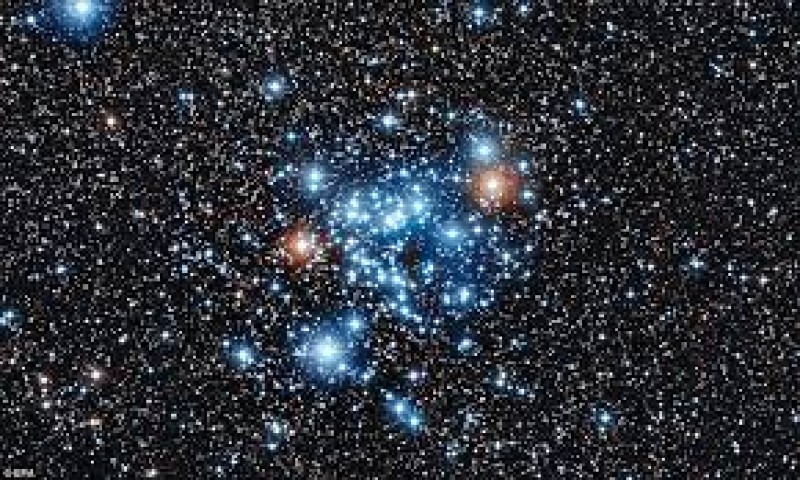
This colorful and star-studded view of the Milky Way galaxy was captured when the Hubble Space Telescope pointed its cameras towards the constellation of Sagittarius (The Archer). Blue stars can be seen scattered across the frame, set against a distant backdrop of red-hued cosmic companions. This blue litter most likely formed at the same time from the same collapsing molecular cloud. The color of a star can reveal many of its secrets. Shades of red indicate a star much cooler than the Sun, so either at the end of its life, or much less massive. These lower mass stars are called red dwarfs and are thought to be the most common type of star within the Milky Way. Similarly, brilliant blue hues indicate hot, young, or massive stars, many times the mass of the Sun. A star's mass decides its fate -- more massive stars burn brightly over a short lifespan and die young after only tens of millions of years. Stars like the Sun typically have more sedentary lifestyles and live longer, burning for approximately ten billion years. Smaller stars, on the other hand, live life in the slow lane and are predicted to exist for trillions of years, well beyond the current age of the Universe. (Image Credit: ESA, Hubble, and NASA)
The cataloging of stars has seen a long history. Since prehistory, cultures and civilizations all around the world have given their own unique names to the brightest and most prominent stars in the night sky. Certain names have remained little changed as they passed through Greek, Latin, and Arabic cultures, and some are still in use today.
As astronomy developed and advanced over the centuries, a need arose for a universal cataloging system, whereby the brightest stars (and thus those most studied) were known by the same labels, regardless of the country or culture from which the astronomers came.
This past year, the International Astronomical Union (IAU) Working Group on Star Names formally approved 86 new names for stars, which are now in the IAU stellar name catalog. The catalog now contains the approved names of 313 stars.
Astronomers during the Renaissance attempted to produce catalogs of stars using a set of rules. The earliest example that is still popular today was introduced by Johann Bayer in his Uranometria Atlas of 1603. Bayer labelled the stars in each constellation with lowercase Greek letters, in the approximate order of their (apparent) brightness, so that the brightest star in a constellation was usually (but not always) labelled Alpha, the second brightest was Beta, and so on. For example, the brightest star in Cygnus (the Swan) is Alpha Cygni (note the use of the genitive of the Latin constellation name), which is also named Deneb, and the brightest star in Leo (the Lion) is Alpha Leonis, also named Regulus.
Unfortunately, this scheme ran into difficulties. Incorrect estimates and other irregularities meant it wasn't always accurate. For example, the brightest star in Gemini (the Twins) is Beta Geminorum (Pollux) while Alpha Geminorum (Castor) is only the second brightest star of the constellation. Also, the Greek alphabet only has 24 letters, and many constellations contain far more stars, even if the naming system is restricted to those visible to the naked eye. Bayer attempted to fix this problem by introducing lower case letters from the modern Latin alphabet (a to z), followed by uppercase letters (A to Z) for the stars numbered 25 to 50 and 51 to 76 respectively in each constellation.
Nearly 200 years after the introduction of Bayer's Greek letter system another popular scheme arose, known as Flamsteed numbers, named after the first English Astronomer Royal, John Flamsteed. Observing at Greenwich, Flamsteed made the first major star catalog with the aid of a telescope, published posthumously in 1725. What we now know as Flamsteed numbers were not actually allocated by Flamsteed himself but by a French astronomer, Jerome Lalande, in a French edition of Flamsteed's catalog published in 1783. In this scheme, stars are numbered in their order of right ascension within each constellation (for example 61 Cygni).
Other designation schemes for bright stars have been introduced, but have not seen the same level of popularity. One such scheme, which built on Flamsteed numbering, was introduced by the American astronomer Benjamin Gould in 1879. Only a handful of stars are occasionally referenced with the Gould scheme today -- for example 38G Puppis.
Alphanumeric Designations and Faint Stars



Stars discovered recently will inevitably be much fainter than those cataloged under the Bayer or Flamsteed schemes. As astronomers discover these new stars to study, it is standard practice to identify them with an alphanumeric designation. These designations are practical, since star catalogs typically contain thousands, millions, or even billions of objects, such as that released from ESA's Gaia satellite.
Several catalogs of faint stars exist and have been around for many years, such as the Bonner Durchmusterung (BD), the Henry Draper Catalog (HD), and the General Catalog (GC) of Boss. The BD is supplemented by the Cordoba Durchmusterung (CD) and the Cape Durchmusterung for stars in the southern hemisphere. Other catalogs commonly used are the Smithsonian Astrophysical Observatory Catalogue (SAO), the Bright Star Catalogue (Harvard Revised Photometry, HR), or the Positions and Proper Motions Catalogue (PPM). The same star can appear in several catalogs, each time with a different designation. As an example, Betelgeuse is known as Alpha Orionis, HR 2061, BD +7 1055, HD 39801, SAO 113271, and PPM 149643.
Binary and Multiple Systems
Stars in binary or multiple systems are labelled in a variety of different ways -- by capital letters from the Latin alphabet if the star has a common colloquial name, by Bayer name, by Flamsteed designation, or by a catalog number. For example, the brightest star in the sky, Sirius, has a white dwarf companion which is catalogued as each of the following: Sirius B, Alpha Canis Majoris B, and HD 48915 B.
Variable Stars
In 1862, a cataloging scheme for variable stars, those whose brightness appears to fluctuate over time, was proposed by German astronomer, Friedrich Wilhelm Argelander. Proposing to build on Bayer's scheme, Argelander suggested using the leftover letters R to Z for the variable stars contained in each constellation (and also occasionally Q, for example in Centaurus, Puppis, and Vela).
Initially, the nine available letters seemed more than sufficient to label the small number of variable stars in each constellation. The number of these stars discovered grew, however, and soon Argelander's scheme was extended to two letter names, and then to include numbers.
Today, variable stars are cataloged in a few slightly different ways, as a result of their order of discovery. In each constellation, the first variable to be discovered is assigned the letter R and the Latin genitive of the constellation name, such as R Andromedae. The second discovered variable is dubbed S, continuing in this fashion up to Z, following which two letter names are introduced, such as RR Lyrae. This is followed by RS up to RZ, and then SS to SZ, and so forth up to ZZ. If more variable stars are discovered past this stage, the scheme returns to AA to AZ, BB to BZ and so on, up to QQ to QZ. Interestingly, the letter J is omitted in this scheme to avoid confusion with the letter I.
Such a system provides 334 possible unique designations for variable stars in a constellation. If even more are discovered, the catalog turns to designations whereby the constellation name is preceded by the letter V and a number, for example V 1500 Cygni, which can continue indefinitely. The exceptions are those variable stars already assigned a Bayer name, which are not given a new name according to this scheme (such as Delta Cephei, Beta Lyrae, Beta Persei, or Omicron Ceti).
As a further addition, the type of variable star is classified based on a well known, typical example. Such examples include Mira stars, RR Lyrae stars, or Delta Cephei stars (also known as Cepheids).
Novae and Supernovae
Another slightly different alphanumeric system is used for novae and supernovae -- stars that have undergone incredible illumination due to extreme nuclear explosions. Novae are assigned designations according to their constellation, together with the year their superlumination event occurred (for example Nova Cygni 1975), and are later given designations based on variable stars. Indeed, Nova Cygni 1975 is the same object as the aforementioned V 1500 Cygni.
Supernovae are also named for their year of occurrence, together with SN and an uppercase letter, such as in SN 1987A. If a single year is particularly flush with supernova events, a double lowercase designation is used (for example SN 1997bs).
IAU List of Star Names
In 2016, the IAU mobilized the Working Group on Star Names (WGSN) under its Division C (Education, Outreach, and Heritage), whose purpose was to formally catalog the names of stars, beginning with the brightest and best known. The Working Group is composed of an assortment of astronomers from all over the world who bring different perspectives and experience to its decisions.
Alphanumeric designations are useful for astronomers to officially identify the stars they study, but in many instances, for cases of bright stars, and stars of historical, cultural, or astrophysical interest, it can be more convenient to refer to them by a memorable name. Many such names are already in common parlance, and have been for a long time, but until the establishment of the WGSN there was no official, IAU-approved catalog of names for the brightest stars in our sky.
The Working Group aimed to solve the problems that have arisen over the centuries as different cultures and astronomers gave their own names to stars. Even until recently, some of the most famous stars in the sky -- such as Sirius, Rigel, and Betelgeuse -- had no official spelling, some stars had multiple names, and identical names were sometimes used for completely different stars altogether.
As an example, a cursory perusal through historical and cultural astronomy literature finds over 30 names for the star commonly known as Fomalhaut. While this particular spelling has seen the most use over the centuries, similar instances in literature have included Fom-al hut al-jenubi, Fomahandt, Fomahant, Fomal'gaut, Fomal'khaut, Fomalhani, Fomalhut, Formalhaut, Fumahant, Fumahaut, and Fumalhaut.
By creating an IAU-endorsed stellar name catalog, confusion was reduced. The unique IAU star names are also not available in the future to name asteroids, planetary satellites, and exoplanets so as to further reduce confusion.
To approve the list of star names, the WGSN took into account worldwide astronomical history and culture, looking to determine the best known stellar appellations to use as the officially recognized names.
Although there is no rigid format that stellar names must follow, since they have their roots in many varied cultures and languages, the Working Group established some initial, basic guidelines that built on the lessons from other IAU Working Groups. The guidelines outlined a preference for shorter, one word names that were not too similar to existing names for stars, planets, or moons, as well as those that have roots in astronomical and historical cultural heritage from around the world.
As mentioned previously, most star names used by astronomers have come from Arabic, Greek, or Latin origins. Now, the International Astronomical Union (IAU) Division C Working Group on Star Names (WGSN) has formally approved 86 new names for stars drawn from those used by other cultures, namely Australian Aboriginal, Chinese, Coptic, Hindu, Mayan, Polynesian, and South African.
The WGSN consists of an international group of astronomers who catalogue and standardise names for stars to be used by the international astronomical community and others. Previously, the WGSN approved the names for 227 stars. With this new addition, the catalogue now contains the approved names of 313 stars.
"The IAU Working Group on Star Names is researching traditional star names from cultures around the world and adopting unique names and spellings to avoid confusion in astronomical catalogs and star atlases," says Eric Mamajek, chair and organizer of the WGSN. "These names help ensure that intangible astronomical heritage from skywatchers around the world, and across the centuries, are preserved for use in an era of exoplanetary systems."
Exoplanets are planets around stars other than our Sun, thousands of which have been discovered in recent years.
For example, the names Xamidimura and Pipirima were approved for components of the bright binary star mu-1 and mu-2 Scorpii in the constellation of Scorpius, respectively. Xamidimura refers to the xami di mura (eyes of the lion), a nickname for the binary among the Khoikhoi people of South Africa. Pipirima refers to inseparable mythological twins from a Tahitian legend where a boy and a girl who ran away from their parents and became stars in the sky. 17th century star atlas used Greek letters, like lower case u (mu), for stars in each constellation in approximate order of brightness.
A total of eleven Chinese star names were incorporated into the Working Group's star name catalog, with three names coming from those of lunar mansions. Lunar mansions are vertical strips of sky that act as markers for following the nightly progress of the Moon -- like a kind of zodiac -- providing the basis for a lunar calendar. The names of two ancient Hindu lunar mansions were included as well: Revati and Bharani, for the stars designated Zeta Piscium and 41 Arietis, respectively.
Among the diverse names from around the world assigned to bright stars by the IAU's WGSN over the past year include the Yucatec Mayan name Chamukuy (the name of a small bird) for the bright star Theta-2 Tauri in the Hyades star cluster in Taurus. Four Aboriginal Australian star names were also added to the IAU stellar name catalog, including the Wardaman names Larawag, Ginan, and Wurren for the stars designated Epsilon Scorpii, Epsilon Crucis, and Zeta Phoenicis, respectively, and the Boorong name Unurgunite for the star Sigma Canis Majoris (an ancestral figure who fights the Moon). Aboriginal Australians are among the oldest continuous cultures in the world, going back more than 65,000 years, representing some of the most ancient star names in the IAU catalog.
The brightest star with a name adopted by the IAU in this latest batch is the 2nd magnitude star Alsephina, assigned to the star designated Delta Velorum. The name stems from the Arabic name al-safinah meaning "the ship," referring to the ancient Greek constellation Argo Navis, the ship of the Argonauts. It was first used in a 10th century Arabic translation of the Almagest, the great book written by the Greek astronomer Ptolemy in the second century AD. Although the name originally referred to an entire constellation, it was assigned to this particular bright star at least as early as 1660, when it appeared in Andreas Cellarius's Harmonia Macrocosmica, a renowned 17th century Dutch magnificently illustrated book about the cosmos. Numerous stars have names with Greek origins that were translated to Arabic and then to Latin during the Middle Ages or the Renaissance. Such convoluted histories for star names are not uncommon.
Two bright stars, one in the northern constellation Cygnus and another in the southern constellation Corvus, have been known for centuries by the duplicate name Gienah of Arabic etymology. To reduce confusion, the name Gienah was retained as the name for the star Gamma Corvi, and Aljanah was approved for Epsilon Cygni, in keeping with its original etymology (Al-janah is Arabic for the wing).
Among the nearest stars to the Sun, the WGSN recognized the name Barnard's Star, which has been in common use for a century, referring to the famous nearby red dwarf star discovered by astronomer Edward Emerson Barnard in 1916. The proper names for three nearby Sun-like stars were approved this past year, including Alsafi for Sigma Draconis, Achird for Eta Cassiopeiae, and Tabit for Pi-3 Orionis, the brightest star in the shield of the constellation Orion.
The IAU is the international astronomical organization that brings together more than 10,000 professional astronomers from almost 100 countries. Its mission is to promote and safeguard the science of astronomy in all its aspects through international cooperation. The IAU also serves as the internationally recognized authority for assigning designations to celestial bodies and the surface features on them. Founded in 1919, the IAU is the world's largest professional body for astronomers.
Source: Guy Pirro